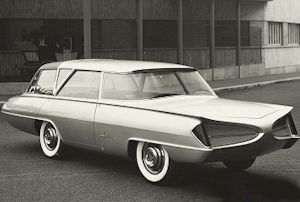These two remarkable, rear-engined design studies put the steering wheel, driver, and front passenger forward of the front wheels, and the engine protruding in its own rear compartment. It was “two box” thinking, only in reverse.

Ghia Selene 1959
- YEAR REVEALED 1955
- PLACE OF ORIGIN Turin, Italy
- HISTORICAL STATUS prototype
- ENGINE none fitted, but said to be suitable for engines from 61–153ci (1,000-2,500cc)
- MAXIMUM POWER unknown
- LAYOUT rear-mounted engine driving the rear wheels
- BODYWORK four-door, five-seater sedan and canopy entry/single-door, three-seater coupé
- TOP SPEED unknown
- NUMBER BUILT two
The Selene I grew out of a Ghia design program for Renault, itself a champion of rear-engined cars. Unlike the ugly Renault 900 study, though, the Ghia Selene would be startlingly futuristic-oozing the jet-age imagery characteristic of many 1950s Ghia show cars, and with an engine at the extreme back like some contemporary airliners.
The work of young stylist Tom Tjaarda, a most astonishing feature was a steering wheel that could switch from left- to right-hand drive, with two sets of pedals permanently in position on the floor. In the rear compartment, two pairs of seats faced each other, with a built-in cocktail bar for mobile “relaxation.” The car was meant to predict an age of superhighways, where electronic controls did the navigation work and car occupants sailed along in serene comfort.
Nevertheless, this didn’t take into account the undoubted vulnerability the Selene driver would feel, pushed out so far in front. Ghia built its gleaming white Selene II in 1960, along similar lines but a three-seater-a single driving seat and two facing seats, and an built-in TV, in the back. This time, the shape was executed by American Virgil Exner Junior, whose father oversaw design at Ghia client Chrysler; it was even more way-out, sportier, and even less practical.